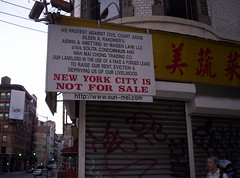Wednesday, November 30, 2005
Number 5, in a series
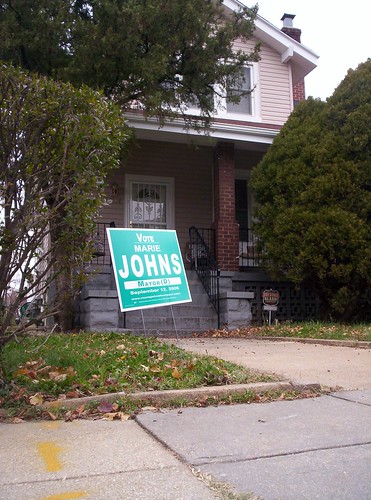 Brookland.
Brookland.The other political scuttlebutt is that the powers that be (Congress, the White House) don't like the passel of Mayoral candidates and are encouraging Mayor Williams to get back in the race. They must not be too sure that CM Cropp can beat the "populist" Adrian Fenty.
Interesting place, Washington, DC.
Oh, two things worry me about Marie Johns: (1) the last two utility executives in city government, Harold Brazil, and Sharon Pratt Kelly, didn't do that good of a job. (2) I hate how she refers to citizens as customers. It's as citizens that we deserve and demand quality, and it is as citizens that we drive the process of democracy.
That being said, people speak highly of her.
Highest and best use of Federal Land?
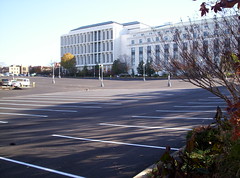
In February, Steve Morris wrote a letter to the editor of the Post, "In the District, Lots of Wasted Opportunity," about the underutilization of prime land around Congressional buildings for parking lots. I've been meaning to take photos for some time. A few weekends ago they were repainting the lines of the lot by the Hart and Dirksen buildings.
Plus, free parking for Congress workers encourages pro-automobility behaviors. I know of people who live a few blocks from the Capitol who drive because they have free parking...
Engaging "local" businesses in neighborhood cleanliness
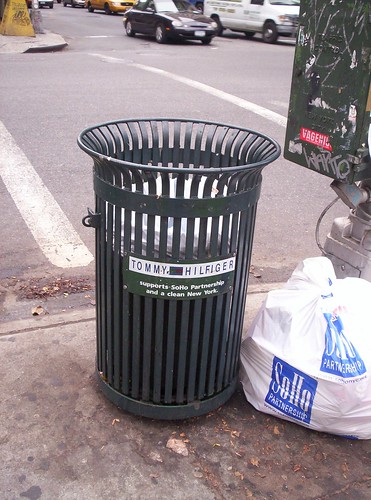 Trash can in SoHo, Manhattan.
Trash can in SoHo, Manhattan.While I think that dealing with merchants takes a lot of time and energy and can be infinitely frustrating, we do have opportunities to better engage them and provide "naming opportunities." (Of course, I've been cut off on my bike by a truck with a "I'd rather be biking" bumper sticker.)
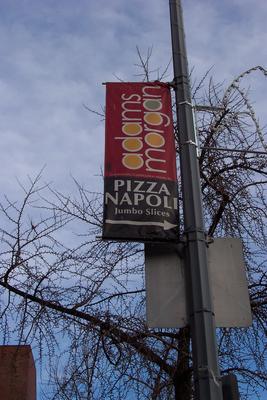 Adams-Morgan, Washington.
Adams-Morgan, Washington.
Schoolkids at Logan School
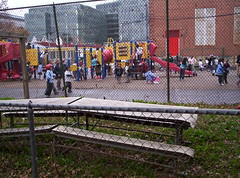
I took this photo to illustrate the point that historic buildings are "better" places to educate kids than the urban brutalist modern edifices that have been built since the late 1950s. Technically, Logan School isn't open, but students from Thompson School have been going here for the many years that Thompson (at 12th and L Streets NW) has been undergoing renovation.
Still and all, I got the first degree for taking this and two more photos, even though I clearly don't have a telephoto lens and wasn't interested in taking close ups. I haven't got around to complaining to the various commanding officers of the policeman that grilled me, demanded my social security number (which I decided not to provide, etc.). There is a fine line between police harassment and protecting children or citizens and I think the police need more training.
Tuesday, November 29, 2005
Kaplan's Ben Hur
I wrote about the closing of this Houston area department store earlier in the month and I came back to the entry in a roundabout way. This flickr photo shows the street sign. I asked the photographer, vanita, about the store, and this is what she had to say:
You asked me about the area it is in... Here in Houston it's in an old neighborhood called The Heights. The area has ebbed and flowed in desirability. Currently it is enjoying substantial renovation and area-sensitive new construction, which is basically Victorian style. That said, you still encounter run down areas as well as the reclaimed areas within the neighborhood.
Kaplan's seemed frozen in time as a 1950's old style department store. It most certainly did not trend along with Foley's and Dillard's or any other store that followed fashion trends in terms of both merchandise and the display of said merchandise.
Both my mother and mother-in-law are long time Houston residents, women in their 70's, and they both have definitely known of it, but used it very rarely over the years. They both think of Kaplan's as having higher end
items and above-and-beyond customer care.
My husband looked up the following Houston Chronicle article on the store for you...
http://www.chron.com/CDA/archives/archive.mpl?id=2003_3644725
Plus he also found this...
A snip from another article about funny Houston names:
In the Heights, Dave and Bessie Kaplan sold clothing at Kaplan's Department Store, which they opened in 1913. Both their sons, Bennett and Herman, fought in World War II and wanted to work with their parents when they returned from the war.
But the store's revenues weren't sufficient to cover two more people on the payroll, says Martin Kaplan, Dave and Bessie's grandson. Dave pointed out the empty building space next door to Kaplan's and suggested the sons openanother business there. The two combined their names and opened a business called Ben-Hur ("Her" sounded too feminine, Martin speculates), which dealt in home and kitchen furnishings - items not produced during the war and very scarce.
"In the public's eye, we've always been one store," says Martin, the only child of Bennett and Dorothy Kaplan. Herman died a bachelor.
Another thought about vocational education and small business development
I mentioned at the Citizen Summit that when you talk to people who own small businesses in the DC area, often if they are of a certain age, it turns out that they went to schools like Armstrong and Phelps, vocational high schools that were closed by DC Public Schools in the 1990s.
Too many people think of vocational education quite narrowly. First, many people who get a vocational education do go on to college. Second, many people with a vocational education later go on to open new businesses, acquire businesses, etc.
So one way to think of vocational education is as one of the seeds of small business development.
Smart thinking on city parking
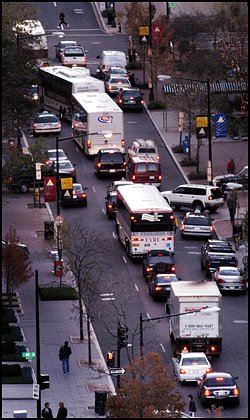 Photographer: Gerald Martineau/The Washington Post. Traffic Congestion and double parking Caption: Evening rush hour traffic funnels to one lane traveling south on 19th St, NW because of illegal parking at curbside. From "Free Parking May End For D.C. Employees: Traffic Panel Offers Gridlock Solutions"
Photographer: Gerald Martineau/The Washington Post. Traffic Congestion and double parking Caption: Evening rush hour traffic funnels to one lane traveling south on 19th St, NW because of illegal parking at curbside. From "Free Parking May End For D.C. Employees: Traffic Panel Offers Gridlock Solutions"Mark Alan Hughes is a professor at Penn and he writes a weekly op-ed column in the Philadelphia Daily News. Today's column "TOUGH PARKING, TASTIER CENTER CITY " talks about how planning for parking must not take a path that diminishes the city's competitive advantage. From the column:
... I raise it now to discuss an important report on parking in Center City [Philadelphia].Whenever you get the feeling, "Who could argue with that?", it's time to look for the Hobson's choice. Reject the premise of the balanced strategy. Yes: residents, workers, and visitors need each other. That combination creates the cocktail we call the 24-hour downtown. But it does NOT follow that parking policies important to each group should be balanced.
Center City's only comparative advantage for residents, workers OR visitors is density. We have a grid of narrow streets and short blocks. We're more like Greenwich Village than midtown Manhattan. That's what brought and keeps anyone here, and that's the kind of residents, workers and visitors we should be luring. People looking to live, work or visit places with cheap and convenient parking don't really want to be in Center City anyway. Catering to them loses eventually because there will always be a place to live or work or visit that has better parking.
The choice is to preserve - or not - the qualities that are attracting thousands of new investors every year - a parking policy that includes making meters expensive enough to ensure available spaces on every block, raising the price of resident parking permits and limiting the number to existing spaces, requiring underground garages that don't disfigure the streets that now draw people from around the world and regulating sidewalks to serve as places to walk rather than as driveways.
That's a Center City in which parking is expensive but worth it.
____________________
It's the same for DC. No different at all.
I had almost the exact conversation with someone the other night--we were talking about the Giant Supermarket at the Tivoli, and the "fight" over getting Giant to yield its illegally seized driving lane inserted into the sidewalk-public space along Park Road. And I used almost the same language as Professor Hughes. I said something like "The comparative advantage that the city has is its pedestrian-centric urban design. Every time we discard this in favor of the car, we chip at and diminish the primary advantage that the city has."
Also see this blog entry from March, "The High Cost of Free Parking."
Unexpected Delivery For Georgetown Postal Store
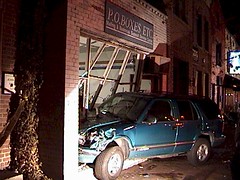 I missed reports of this (from the www.dcfd.com website). "A Georgetown postal packaging store got quite an unexpected delivery on Friday evening, November 18, when an SUV slammed through the establishment's front window. "
I missed reports of this (from the www.dcfd.com website). "A Georgetown postal packaging store got quite an unexpected delivery on Friday evening, November 18, when an SUV slammed through the establishment's front window. "
Corruption is alive and well, in DC and across the good ole USA
The last couple days worth of Posts had a bunch of articles about egregious municipal waste and contracting corruption. I didn't write about it because I am cynical. That's the way things are.
In fact, the Post did an editorial about the series today, "On the Mayor's Watch," which starts out with this quote: "The city loses $30 million to $40 million each year, budget analysts estimate, because contracts are poorly written, are not competitively bid and are plagued by cost overruns. " This is from a 1997 editorial!
The more things change, the more they don't....
So I think of it as deliciously ironic that Mayor of DC Tom Davis, oops, I mean local Virginia Congressman Tom Davis, in today's Post article "U.S., City Officials Demand Spending Probe," states that: "The violations could set back efforts to give the District more independence from Congress" when the front page of the Post has an article about a Congressman pleading guilty to accepting bribes, said bribes leading to a defense contractor winning over $122 million!!!!!!! in contracts. (See "Congressman Admits Taking Bribes, Resigns.")
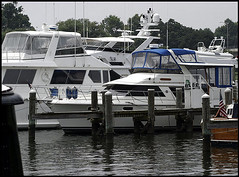 MZM owner Mitchell J. Wade's yacht, the Duke-Stir, foreground, is part of a probe of Wade's relationship with Rep. Randy "Duke" Cunningham (R-Calif.). (By Sarah L. Voisin -- The Washington Post)
MZM owner Mitchell J. Wade's yacht, the Duke-Stir, foreground, is part of a probe of Wade's relationship with Rep. Randy "Duke" Cunningham (R-Calif.). (By Sarah L. Voisin -- The Washington Post)I don't justify corruption, but there's an awful lot of it, at all levels of government. Halliburton? All the various contracting scandals? Taking shortcuts in New Orleans levee construction? The levee districts spending money on things like promoting casinos rather than maintaining and improving levees (see "Holes in the Dike: Long Before Flood, New Orleans SystemWas Prime for Leaks," from the Wall Street Journal), etc...
This is why I am skeptical of claims for smaller government on behalf of "conservatives." It's really merely a matter of who benefits most from the government trough.
By the way, the same Post Metro section today has articles about "corruption" in planning in Clarksburg, Montgomery County ("Planners Set Clarksburg Fines at $2.11 Million but Urge Mediation") and in Baltimore ("Md. Businessman Mentioned In Probe of Former Senator "). The latter article has this great quote from a major developer-businessman in Baltimore, John Paterakis:
"You try to be good to the political people. They make the laws."
They also manage a big revenue stream and hand out a lot of contracts.
Building Public Will and Rivers
In October I wrote about one of the better sessions at the National Trust conference, about fundraising and "building public will" to engender social change. One of the examples the presenter gave was about rivers, and how general concerns about stewardship and environmentalism don't really resonate, but that health messages do, especially because 70% of drinking water comes from local rivers.
A perfect example of this message is in the very long piece in this weekend's Washington Post Magazine about this very issue: "Silent Streams: Sprawl is threatening almost every stream in the country. But a rising citizens movement is trying to save one of our most important natural resources before it's too late." For a media person, this article is the pot of gold at the end of the rainbow!
 Anacostia River. Source: Anacostia Watershed Society.
Anacostia River. Source: Anacostia Watershed Society.This paper, "Building Public Will: A communication approach to creating sustainable behavior change," explains the concept.
Unique street lamps
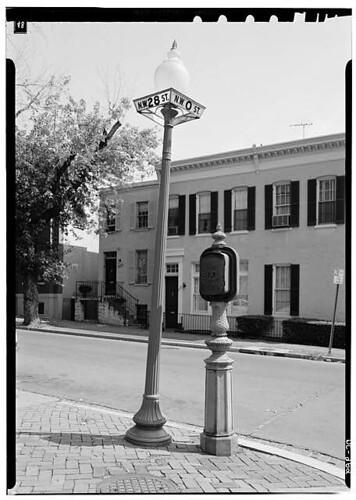 Historic American Buildings Survey Jack E. Boucher, Photographer September 1969 CALL BOX AND STREET LAMP 28th AND O STREETS, N.W. HABS DC, GEO,120-3. Souce: Library of Congress.
Historic American Buildings Survey Jack E. Boucher, Photographer September 1969 CALL BOX AND STREET LAMP 28th AND O STREETS, N.W. HABS DC, GEO,120-3. Souce: Library of Congress.This photo from 1969 demonstrates that not that long ago, DC still had more unique street lamps and signage in various neighborhoods around the city.
Co-op Market Venture moves forward
(Note: there is a yahoogroup, hstreet_foodcoop, that people can subscribe to)
From Holly Smith:
As you may know, the H Street Community Market was very fortunate to have recently been one of four entities across the entire country to be the recipient of the Food Co-op 500 Seed Fund Grant!! The grant is a matching grant in which we will be given $10,000 if we can raise $10,000 dollars of our own funds. It can be drawn down in tranches as we have the matching funds. We plan to use the money to do a feasibility study for the food co-op and to move towards the establishment of a store front on H Street. We are very excited that all our sweat and hard work over the past years is now really coming to fruition!!
We currently have close to $3,000 that we have raised, and we would like to increase that figure to at least $5,000 before mid December so that we draw down on our first tranche of money and begin the feasibility study. As the co-op is a "cooperative" effort, we really need everyone's participation to help us meet our goal. As discussed before, the individual equity share to join the co-op is $200. You are the core group of people behind this movement, and for this reason, we would like to encourage everyone to begin contributing their equity. If you are not able to contribute the entire $200 at this point, then please feel free to make a starting contribution. Please remember that your equity contribution makes you an owner in the H Street Community Market, and the profits, or patronage, once we open the business will be distributed accordingly. In addition, your equity share is always refundable should you decide to leave the co-op (which we hope you never will!) And, most importantly, you will be helping to promote a community imitative that we really make a difference on H Street!
Please send an email with your equity pledge amount, and kindly mail checks payable to the order of the H Street Community Market no later than December 10. You can mail your checks c/o Emily Raynor, 136 R Street NE, Washington DC 20002. Also, if you have any questions, please do not hesitate to contact me on my cell phone at 240-481-0105.
Many thanks,
Emily Luisa Raynor, Treasurer and Member of the Board
H Street Community Market
P.S, Please be on the lookout for announcements to come about our upcoming fundraiser in February!!!!
___________
Personally, I think a great place for a co-op market would be in a revitalized Florida Market area...
More learning from Los Angeles -- "L.A. Renews Its Libraries as Modern Civic Centers"
 ‘NEUTRAL TERRITORY’: Eric Johnson, 17, a senior at Jefferson High School, helps Andrew Hernandez, 5, with his reading at the new Ascot branch library. (Christine Cotter / Los Angeles Times). As part of a $317-million program, the Los Angeles Public Library is adding 47 branches, bringing the city's total to 72. The new ones are designed to be large, high-tech and inviting. Many new branches, designed with input from the neighborhoods they serve, have become landmarks and have helped to strengthen the sense of community in Los Angeles.
‘NEUTRAL TERRITORY’: Eric Johnson, 17, a senior at Jefferson High School, helps Andrew Hernandez, 5, with his reading at the new Ascot branch library. (Christine Cotter / Los Angeles Times). As part of a $317-million program, the Los Angeles Public Library is adding 47 branches, bringing the city's total to 72. The new ones are designed to be large, high-tech and inviting. Many new branches, designed with input from the neighborhoods they serve, have become landmarks and have helped to strengthen the sense of community in Los Angeles.In view of all my post-Citizen Summit writing about not getting the point about planning, that making great places is economic development, comes this article from the Los Angeles Times, "L.A. Renews Its Libraries as Modern Civic Center--More than just housing books, the new and refurbished branches bring people together." From the article:
On a dusty, hot summer afternoon in South Los Angeles, 13-year-old Joseph Robinson and 9-year-old Franklin Flores are in a favorite place — huddled in front of a computer terminal playing RuneScape together. For the boys, one black and one Latino, the new Ascot branch library at Florence Avenue and Main Street is their daily meeting place, a refuge from a gritty neighborhood where interracial tensions recently sparked violence at a local high school.
In the Pico-Union neighborhood, older residents go to their new branch for a library-sponsored Coffee and Conversation, which brings together strangers to talk about Iraq, immigration or whatever topic may be in the news. And in Chinatown, dozens of immigrants flock to the 2 1/2 -year-old branch for a weekly citizenship class at which, between gossiping with friends, the students prepare for the test by shouting out answers to questions about the Constitution, communism and the Supreme Court.
This is the new face of public libraries in Los Angeles — versatile and thoroughly modern places that have fueled a 70% explosion in library usage over the last decade. It was not always so. For years, cramped and crumbling branches testified to a civic purpose sapped by riots, tax revolts and urban decay.
Today, Los Angeles is nearing the completion of a $317-million modernization program to build and renovate 63 branch libraries, finishing them on time and under budget. Librarians from as far away as Singapore and Sweden have come to see what the city has accomplished.
How Los Angeles rebuilt its libraries is more than just a public works success story.In an atomized city where social isolation is almost a civic credo, the rebirth of branch libraries appears to reflect another side of the metropolis, both more prosaic and more humane. Libraries are filling a demand for community. These public institutions are encouraging ties between immigrants and their new city as well as helping to bridge divisions of class and race with the simple act of bringing Angelenos together in safe, beautiful spaces.
______
Libraries, Schools, Parks and other public assets need to be considered not merely from the often too myopic perspective of the agency and what they perceive as "their" property portfolio, but as the building blocks of great neighborhoods and a great city, as amenities for neighborhoods, and as the social institutions that bring people together and help create true community.
Forcing Displacement by the disconnection of tax assessment models from public policy goals
Today's New York Times has an article about that perennial topic, artists being priced out of their own success--where arts and culture is used to seed revitalization, and as revitalization occurs, the escalation in rents and/or property taxes prices out artists. Today's article, "Artists Feel the Squeeze in a Midwest SoHo," is about Kansas City.
Similarly, last week, the Post had an article by Eric Weiss, "NW Businesses Fear Skyrocketing Taxes Will Push Them Out," about how rising property taxes are pricing out local businesses.
At the time, I didn't feel like writing about the article because I already wrote about this issue in April, when I testified about this issue extemporaneously at a DC City Council hearing about the DC Main Streets program. (See "Displacement of retail businesses through increasing property tax assessments" and "Yesterday's testimony on the DC Main Streets program.")
 Property taxes for Ben's Chili Bowl, on U Street NW, are going up 150 percent next year as its assessment jumps from $438,310 to $1.1 million. (Photo By Michael Williamson -- The Washington Post)
Property taxes for Ben's Chili Bowl, on U Street NW, are going up 150 percent next year as its assessment jumps from $438,310 to $1.1 million. (Photo By Michael Williamson -- The Washington Post) What I said then is no less relevant. The property tax assessment model is disconnected from revenue generation models based on what retail businesses can sell in buildings of sizes typical of historic buildings in our city's commercial districts. A theoretical "highest and best use" model will always price out anything other than commercial office, because such high revenue producing, low service requirement properties are the absolute best financial deal for any city.
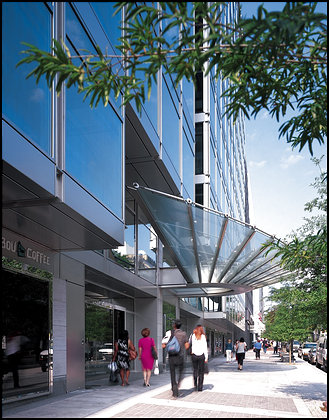 Photo by Maxwell MacKenzie. Retail front, 1700 K Street NW. From a developer's perspective, "the highest and best use" for every piece of property in Washington, DC is a 10-15 story office building.
Photo by Maxwell MacKenzie. Retail front, 1700 K Street NW. From a developer's perspective, "the highest and best use" for every piece of property in Washington, DC is a 10-15 story office building.While I think this is a high estimate, it's likely that Ben's Chili Bowl grosses no more than $3 million/year. Granted the business has been more successful as of late, adding more seating capacity in the rear a few years ago, but there's no way that over the course of the improvement in the U Street area, that Ben's business increased by much more than 25%. Even a 50% business increase (very doubtful) how is a 150% increase in property taxes justifiable?
As I said in the testimony, the rule of thumb is that a retail business pays from 4-10% of its annual revenues in rent--or if the property is owned, mortgage plus property taxes and maintenance. (Restaurants because they have higher revenues, tend to pay as much as 15% of annual revenue in rent.)
Similarly, last week the District Extra had an article about the Takoma Theater and the Takoma Theater project, and how the owner, a playwright!!!!!!!!!, now wants to tear it down and build a big project because of the increase in property taxes. (See the article, "Will Takoma Theatre Have a Third Act?")
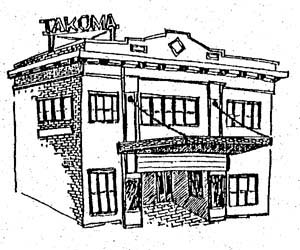 Takoma Theater.
Takoma Theater.When I first was informed of this in August, this is what I wrote on the HistoricWashington email list:
Property tax assessment models for commercial properties need to be based on the revenue models for operating businesses likely to locate in such commercial districts. An tax assessment methodology focused on some "mythical" building worth independent of the businesses located within and the revenue streams they generate is disconnected from business reality. This will lead to business displacement, particularly of independent businesses, in favor of chains, or in significant changes in the use, changes which may be incompatible for a number of reasons. (It's no different than taxing farmland that is being farmed as if it could be redeveloped into residential tracts. Eventually the farmer will have to sell.)
The Theater example you recount is another example of the property tax assessment model being disconnected from the underlying business that operates within the building. WRT Takoma Theater, the building form is intimately tied to a particular type of business.
One of the first things you all should do is challenge the property tax assessment model used by the city for that property. What [is the justification for valuing the building more highly], if it is to be used as a[n independent] theater, that competes in an extremely competitive and "chained" milieu? [brackets denote editing]
The people in Kansas City are starting to understand the overall process, as the Times article states that:
Over the last year, the Crossroads Community Association has been working with the office of Mayor Kay Barnes to draw up a plan that would enable property owners using buildings for creative purposes like studios, fine arts schools or art dealerships to get a tax break. If the plan is passed by the City Council, building owners would pay property taxes based on the original value of their property for 10 years and then 50 percent of the tax value based on the most recent assessment of the property for the next 15.
That is the kind of thing that needs to be done--ensuring, somehow that city tax policies are linked with other city economic development policies. The State of Maryland does some of this with their Arts District enabling legislation, which also provides a variety of tax benefits both to artists as well as to owners of properties with arts and culture uses. See for example this write-up related to the Highlandtown Arts District in Baltimore.
Saturday, November 26, 2005
When seeing isn't believing, how do you correct for vision impairment?
 Jewal Mazique, worker at the Library of Congress, waiting for a streetcar on her way home from work. FSA Photo, Winter 1942, John Collier. Source: Library of Congress.
Jewal Mazique, worker at the Library of Congress, waiting for a streetcar on her way home from work. FSA Photo, Winter 1942, John Collier. Source: Library of Congress.The City Paper reports, in "Exile on Main Street," on the recent trip to Portland, Oregon, for Anacostia-area residents, Councilmembers Vincent Gray (Ward 7) and Marion Barry (Ward 8), and DC DDOT Director Dan Tangherlini, and that the residents who went on the trip came back as opponents of the new plan to put the streetcar system on the street, rather than on a dedicated separated line. I guess this contradicts my blog entry "When people don't have experiences, site visits are the way to go." It's too bad that the people who went to Portland from DC didn't likely talk to the person mentioned in this part of that blog entry:
 Boy on a Washington Streetcar. FSA Photo, 1943, Esther Busby. Source: Library of Congress.
Boy on a Washington Streetcar. FSA Photo, 1943, Esther Busby. Source: Library of Congress.One of the tours I went on in Portland was of the new Yellow Line Light-Rail line, which is located in a more "emerging" area of the city, one that has experienced economic distress, closure of manufacturing, and is also more ethnically and racially diverse.
One of the presenters was a citizen, who originally opposed the light rail because of how it was to be funded -- because the original line was to go from Vancouver, Washington to Oregon City, a city east of Portland (you can't really call it a suburb, as its development really came out of the time it took to travel in one day, back when getting around took a lot longer, i.e., in the mid-1800s), it required a bond approval vote of the entire state. Such a referendum failed twice. So the city of Portland through the Portland Development Commission created an "Urban Renewal District" which allowed for the sale of bonds against future tax revenue increases.
To make a long story short, once this person saw the impact of the new line in terms of greater connectivity and the slow but steady improvements in commercial districts along the tracks, he understands much better why expanding transit makes sense, and today he is a strong supporter.
And the impact of the Light Rail on the Interstate/Yellow Line is nothing at this juncture, when compared to the impact of Light Rail and Streetcar in Portland's Center City.
 Ladies on the Washington Streetcar. FSA Photo, 1943, Esther Busby. Source: Library of Congress.
Ladies on the Washington Streetcar. FSA Photo, 1943, Esther Busby. Source: Library of Congress.While I recognize that DC neighborhoods have suffered for decades from disinvestment, I have come to believe that not all the ills of our neighborhoods can be blamed on abandonment, but can also be attributed to lack of vision, failure to step up and mark hard choices, and a variety of other reasons.
Earlier in the week I wrote with incredulity about the Monday Post article about H Street, in a blog entry I entitled "It helps to have good PR agents." This article seemed to drink in the kool aid that says that urban renewal is a good thing. The neighborhood blog Frozen Tropics also weighed in on the article.
Afterwards I decided to mine the Post archives and I went through 7 years of Washington Post articles (1979-1986) just using the keyword "Hechinger Mall." I intend to write a much longer analysis of what I found--but flu got in the way of my best intentions at least thus far.
In any case, the same kinds of articles about the "revitalization of a neighborhood being right around the corner" kept getting written like clockwork, every couple years. Meanwhile, you could read the drumbeat of unvital signs--the Safeway on H Street closing (because of the Safeway opening at Hechinger Mall), the Post Office on H Street closing (because Hechinger Mall drew away the once even post-riot pedestrian traffic), how the opening of Hechinger Mall didn't lead to a revitalization of the residential neighborhoods around the mall, etc.; picketing of Hechinger Mall construction due to the underutilization af African-American contractors; that Rosalynn Carter made her way on H Street at one point, to herald a new day for this riot-scarred corridor, etc....
Fascinating reading. I guess a key value of the Post is in the accumulation of articles over time.
Anyway, I can't believe that residents with open minds couldn't go to Portland, look at how both the Light Rail (MAX) system and the Portland Streetcar system are integrated into the city, much like streetcars used to be, making transit easily accessible and usable rather than requiring a separate trip-hike to a subway station, and be convinced of the utility here.
On the other hand, looking at that cumulation of Post articles, or the articles listed in the blog entry from earlier in the week, you see that DC residents and business owners have a long history of being disappointed.
Still you can't have progress without a willingness to open your eyes. And if your vision's faulty, the acquisition of vision aids (rather than kool aid).
An idea for opening at least some of WMATA's subway station restrooms--bathroom attendants
From the Chicago Sun-Times article, "Restrooms worth a mint at Metra stop":
Once an unfinished basement of a train station, Metra's made-over Randolph Street stop just got a bit bourgeois -- at least in the bathrooms. That's where bow-tie wearing attendants greet travelers with all the courtesy of their counterparts tending to restrooms in upscale eateries and hip nightspots. The station's bathroom butlers aren't dolling out cigarettes, hot towels and cologne, but riders are offered a mint as a sort of public-toilet parting gift.
_____
A couple subway stations might have the volume able to support restroom attendants, which would allow the restrooms to be opened to the public.
Perhaps New Orleans' Cultural Heritage is Doomed
The architect, writer, and educator John Massengale wrote this on the H-Urban email list, comparing the Mississippi Renewal process to that of New Orleans:
New Orleans, on the other hand, is very different. I am not as involved there, but I went to the Louisiana Recovery Conference organized by the AIA [American Institute of Architects], the APA[American Planning Association] and Mayor Nagin's commission, and I am in regular touch with people who are in some of the meetings at the Governor's office and Senator Landrieu's office.
The factionalism mentioned by Kevin Gotham in a different context is in full swing in New Orleans. Specifically on the rebuilding, people who don't know how to make places are being advised by people who have never made good places. The result, I'm afraid, is going to the simultaneous physical neglect and dismemberment of New Orleans outside the French Quarter and the Garden District, which had little flooding (not because they are on the "high ground," but because their levees didn't break -- both areas are well below the level of the Mississippi as it flows by New Orleans).
The Mississippi process is organized and funded. The Louisiana process is lots of factional discussion and unfunded. More than 85% of the population of New Orleans is scattered around the country, but very little is happening to enable them to know when or if they will be able to come back. An important announcement was supposed to be made by the state earlier this week, but local professionals have prevented the announcement thus far.
I am afraid that the Mayor's Commission is proving to be the LMDC (Lower Manhattan Development Corporation) of Louisiana. That is to say, executives operating outside their fields of expertise, being badly advised, and ignoring the public will. Ground Zero was funded and is moving ahead, but it's current state is an ugly fortified tower that no one wants to be in and a proposed shopping mall straight from the sprawl of New Jersey.
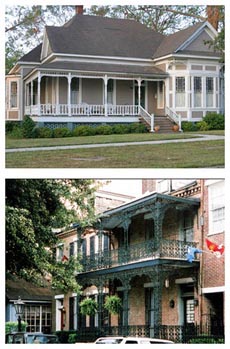 To aid in the rebuilding of Mississippi's Gulf Coast, Rob Robinson of Pittsburgh-based Urban Design Associates created a pattern book of vernacular houses. Shown here are the pyramid, top, and townhouse, above. From "Pittsburgh architects part of team creating designs for devastated Gulf Coast areas."
To aid in the rebuilding of Mississippi's Gulf Coast, Rob Robinson of Pittsburgh-based Urban Design Associates created a pattern book of vernacular houses. Shown here are the pyramid, top, and townhouse, above. From "Pittsburgh architects part of team creating designs for devastated Gulf Coast areas."______
Blair Kamin, the architecture and urban design writer for the Chicago Tribune, has a lot to say about this in his article, "A housing crisis. The cultural stakes could not be higher. New Orleans' extraordinary homes are the essence of this remarkable city. Now, they need help, and they're not getting it from the powers that be." From the article:
Two months after President Bush promised that "this great city will rise again," the risk grows every day that another catastrophe will strike New Orleans -- a catastrophe of ignorance, indifference and missed opportunities to marry rebuilding and the new jobs this impoverished city so desperately needs.
The danger signs are everywhere, from the widespread official support expressed for a new brand of housing that would undermine the city's matchless character to federal foot-dragging on tax measures that would encourage people to rehab New Orleans' extraordinary housing stock. Few in power seem to grasp that the city could use its destruction as a source of regeneration, much as Chicago did after the Great Fire of 1871.
The cultural stakes could not be higher. The homes of New Orleans -- its shotgun houses, Creole cottages, Craftsman bungalows, Southern plantation houses and the lacy, Spanish-style buildings of the French Quarter -- are to this city what skyscrapers are to Chicago: The most visible and visceral expression of the city's essence. Many have been passed down from one generation to another, like treasured heirlooms. No other city has such a high concentration of landmark districts on the National Register of Historic Places....
To be sure, there are some encouraging signs. Last week, for example, a panel of land-use experts representing the Urban Land Institute (ULI), a Washington-based planning organization, wisely suggested that the city's rebuilding occur in phases, starting on the safe high ground. But it is hard not to be skeptical about a new mixed-income housing development here called River Garden and touted by Nagin as a possible model for rebuilding soon-to-be-bulldozed areas. Housing and Urban Development Secretary Alphonso Jackson also has hailed the 60-acre complex.
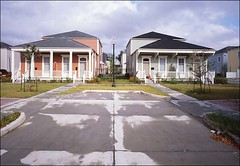 River Place, New Orleans. New York Times Photo.
River Place, New Orleans. New York Times Photo.Located in the Lower Garden District near downtown and principally designed by the in-house architects of the developer, Historic Restoration Inc., River Garden seems charming enough at first glance. Instead of stark modern buildings and streets that echo with the sound of gunshots, as there were at the St. Thomas public housing project it replaced, River Garden is almost eerily quiet. Its apartment buildings unabashedly mimic the architectural traditions of New Orleans. There are fanciful Victorian brackets like those on the city's shotgun houses, lacy ironwork as in the French Quarter, and tall white columns that suggest the Lower Garden District's prevailing Greek Revival style. Such flourishes are trademarks of the school of traditional town planning called the New Urbanism.
But while River Garden represents a progressive social model, its architecture and urban design turn out to be like pizza labeled "Chicago-style" -- a weak echo of the real thing.The colors of the apartment buildings are pallid, not vibrant, as in Bywater and other New Orleans' neighborhoods. The details, like the brackets, are larger, cartoonish versions of their turn-of-the-century predecessors. Single-story, shotgun-style fronts are incongruously stuck onto two-story backs that resemble suburban subdivision homes....
Vacant land turns to gold for insiders: Buyers with clout cash in on parcels
This article from the Chicago Tribune is as important as the series "Squandered Heritage" from 2003, which looked at what the writers called "The Demolition Machine" and the failure of the City of Chicago to systematically protect identified historic building resources.
The kinds of points made in this article are similar to those raised with regard to DC's Home Again initiative ever since it was first launched in 2002/2003. It's all about the Growth Machine.
Touch of suburbia takes root in city: an Olive Garden coming to Boston has greater implications than you realize
 Donato Frattaroli (left), the owner and executive chef at Lucia Ristorante in the North End, said "gradually all the big chains are moving in." Neb Obradovic (right), an employee at Pomodoro, a North End establishment, said his homey restaurant caters to a different crowd. He said the Olive Garden will draw well from the area. (Globe Photos / Lisa Poole). From "Touch of suburbia takes root in city: Olive Garden opening restaurant in Boston."
Donato Frattaroli (left), the owner and executive chef at Lucia Ristorante in the North End, said "gradually all the big chains are moving in." Neb Obradovic (right), an employee at Pomodoro, a North End establishment, said his homey restaurant caters to a different crowd. He said the Olive Garden will draw well from the area. (Globe Photos / Lisa Poole). From "Touch of suburbia takes root in city: Olive Garden opening restaurant in Boston."One of the things that I have been thinking about lately are the issues involved in building a local economy. I think about this in terms of both the Comprehensive Plan revision process as well as the general "Economic Development" initiatives undertaken by the various agencies of the City government, including the individual councilmembers.
At the Citizen Summit last weekend, there were four issue clusters, and three if you think about it, were deeply interconnected -- jobs development, youth development, and libraries.
Our table included a teen, and she talked about how people like her weren't interested in working in places like McDonalds. We then had a spirited conversation about what kinds of jobs are teens interested in. Another tablemate made an excellent point, that more than anything, entry-level jobs for teens and young adults are really about teaching "work ethic"--going to work every day, performing tasks, working with others, balancing competing tasks, etc.

I then made the point that with "chaining up" of local businesses, there are fewer and fewer opportunities for teens to work in area businesses, do to insurance and other requirements that big chains follow. E.g., I got my start "working" by delivering newspapers, including the Detroit Free Press, but in Washington, DC, only adults deliver newspapers (with the exception of occasional children hawking the Washington Times). My first payroll job was in a Big Boy restaurant, a franchised branch of a regional chain that relied on teen workers for help. But even before then, when I was 9 years old I did odd jobs for store owners when I lived "downtown" in a little town in very western Oakland County not too far from Ann Arbor.
Do kids really have these kinds of opportunities now, and do urban Main Street programs have a role to play in trying to foster connections between youth employment and the local businesses.
I think so. And in some respects, the tax incentive programs attracting chains do have some downsides. This being one--reduced youth employment opportunities.
Kid-Made Ads Touting Healthy Foods Appearing in King County (Seattle) Metro Buses

This article "Kids put nutrition in picture with bus ads touting healthy foods," discusses a program which is a good example of engaging children in meaningful ways in learning and in promoting healthful eating, and utilizing public places (transit) to promote socially-beneficial messages. From the website:
After learning about how companies get our attention through vivid advertising, area students wondered if it would be possible to make their own "ads" featuring artwork promoting fresh fruit and vegetables public in their neighborhoods. This month 120 of these student-created ads have been made into interior bus billboards in King County Metro buses. Three different language versions of the ad are appearing, including Spanish, Vietnamese, and Cambodian.
Sponsored by Washington State University Extension Food$ense Program through a grant from the King County STEPS to a Healthier US, the Healthy Foods In Motion Ads will run for at least two months in conjunction with ongoing health and nutrition and gardening education curriculum in the schools developed by WSU King County Extension’s innovative CHANGE (Cultivating Health and Nutrition Through Gardening Education) program.
 Paul Joseph Brown / Seattle Post-Intelligencer. Teacher Trina Anderson with Thorndyke Elementary fourth-graders Alexus Maline, Matthew Balbuene and Eunica Serafica display a poster produced for the Healthy Food in Motion campaign.
Paul Joseph Brown / Seattle Post-Intelligencer. Teacher Trina Anderson with Thorndyke Elementary fourth-graders Alexus Maline, Matthew Balbuene and Eunica Serafica display a poster produced for the Healthy Food in Motion campaign.
Speaking of disorder
HollabackNYC is an interesting blog devoted to people's responses (usually women) to being harrassed on the streets of New York City.
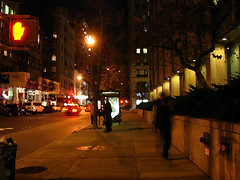 Flickr photo by Lorenzodom.
Flickr photo by Lorenzodom.
Disorder Rules OK

Revellers enjoy themselves in a bar in Newcastle after new licensing laws came into force at midnight. Daily Telegraph photo.
From time to time, I think I've discussed the various UK reports on the Late Night Economy and dealing with late-night revelers. IMO, the foolish UK Government response has been to extend the hours that establishments can be open. The justification is that this limits the release of a horde onto the streets when places all close at the same time, and that it is the havoc of the crowd that contributes to disorder, ranging from fighting to murder. The launch of this new policy was this weekend.
This piece from the Daily Telegraph, "Your view: should pubs open 24 hours?," has some interesting comments and is worth reading.
Wednesday, November 23, 2005
NDC President Adrian Washington Named to lead Anacostia Waterfront Corporation
Somehow I missed this news. See the press release "ADRIAN WASHINGTON, DC NATIVE AND LOCAL DEVELOPER, NAMED TO LEAD ANACOSTIA WATERFRONT CORPORATION" from the Anacostia Waterfront Corporation website. Click here for Adrian Washington's Neighborhood Development Company website (which calls 3rd and L Streets NE part of the "upcoming Stanton Park Neighborhood" ).
It helps to be part of the club. (Note that he is co-chair of the "Comprehensive Housing Study Task Force.")
Google Maps Mania mention
My experiment using Community Walk to create a neighborhood-based Google Map has been mentioned in this entry on the Google Maps Mania blog, which is linked in the right sidebar anyway. This website has amazing Google Maps coverage and lists of resources and innovative examples.
I want to figure out how to reduce the map in size somewhat so that I can place it in the right sidebar "permanently."
A Housing Strategy for D.C.'s Future: Results from the Comprehensive Housing Strategy Task Force
From Washington Regional Network for Livable Communities:
December 7, 2005
6:00 pm refreshments; 6:30 pm program
at the National Capitol Planning Commission
401 9th Street, NWNorth Lobby, Suite 500
with:
Adrian Washington, Neighborhood Development Company & Co-Chair, Comprehensive Housing Strategy Task Force
Marilyn Melkonin, Telesis Company
Nan Roman, National Alliance to End Homelessness
How will D.C. address the needs of all its residents from middle class working families to those threatened with homelessness? How will D.C. ensure that rising demand for housing won't push out long time residents or prevent moderate income families from settling into city neighborhoods? Join a discussion with members of the D.C. Comprehensive Housing Strategy Task Force as they propose strategies and policies to address the city's housing crisis.
View the Comprehensive Housing Task Force report, Homes for an Inclusive City: A Comprehensive Housing Strategy for Washington, D. C.
About WRN's Fall 2005 Fall Forum SeriesThis event is the third in the Fall 2005 forum series: How Should D.C. Grow?. This series will address how D.C. should guide change and growth occurring for the first time in 30 years in D.C. neighborhoods, corridors and business districts. These forums aim to inform the D.C. Comprehensive Plan revision process which is occurring this fall and winter.
RSVP (attendance only): WRN, 202-244-1105, or e-mail. This event is free of charge.
Lots of great web resources
I am constantly adding links, and occasionally reorganizing, when a category reaches critical mass and can stand on its own. Came across the Community Arts Network today. Looks interesting.
A new take on public art
 From "Southwark brings art to the masses - on dustcarts," the UK public sector e-news website www.24dash.com reports on a community that has painted 8 of its garbage trucks as rolling public art.
From "Southwark brings art to the masses - on dustcarts," the UK public sector e-news website www.24dash.com reports on a community that has painted 8 of its garbage trucks as rolling public art.As John Stilgoe says with the title of one of his books, Outside Lies Magic, or at least, opportunity...
Retail founders near Fed Ex Stadium
according to this article, "For Now, Land Near Stadium Used for Parking" from the Pringe George's County Extra section of the Post. Granted that football stadia are used relatively infrequently, but it does communicate about the "economic development power(?)" of sports-driven development.
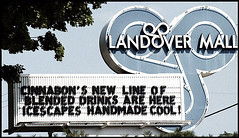 Retail shops have foundered near Fed-Ex Field. Landover Mall closed in 2002. (1999 Photo By Marie Poirier Marzi For The Washington Post)
Retail shops have foundered near Fed-Ex Field. Landover Mall closed in 2002. (1999 Photo By Marie Poirier Marzi For The Washington Post)Interestingly enough, the redevelopment of the Capital Center/US Air Arena into a retail-tainment district seems to have come with some problems as well. See "Largo Mall Slaying Adds to Residents' Fears: 50 Cent Movie Also Troubles Some."
Although I would attribute this to the "if you build it they will come" philosophy. If you build it and the underlying conditions are still reflective of distressed demographics, it is difficult to change the overall conditions of the area merely by constructing new buildings.
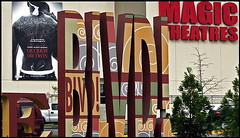 Some residents petitioned the mall's management to stop showing the movie "Get Rich or Die Tryin'." (By Bill O'leary -- The Washington Post)
Some residents petitioned the mall's management to stop showing the movie "Get Rich or Die Tryin'." (By Bill O'leary -- The Washington Post)
More New Orleans...
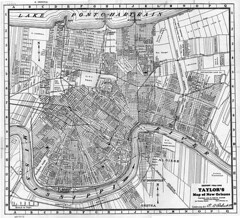
1. Richard Moe, President of the National Trust for Historic Preservation, was interviewed by the Architectural Record:
ARCHITECTURAL RECORD: During Katrina and Rita,many historic buildings were damaged. Where are you focusing your preservation efforts? Richard Moe: We’re trying to save buildings that are in National-registered Districts. These contain 37,000 historic structures in New Orleans. We’re not going to neglect anything, but that’s where we’re focused. There are 20 National Historic Districts in New Orleans. The French Quarter and Garden District are only two of these. The majority of the rest are vernacular houses with Creole cottages and Craftsman bungalows. These are the heart and soul of New Orleans.
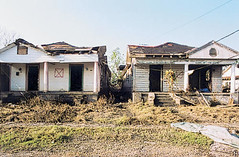 From Metropolis Magazine.
From Metropolis Magazine. AR: What can you do to make sure more historic buildings are saved? RM: We’re asking Congress to appropriate $60 million for a grant program, to be administered through state historic preservation offices, to help people pay for rehabilitation. There’s a desperate need for this, because many can’t afford to rebuild. We will know about that sometime in December. We would like to raise several million dollars to do the same thing. We are also going to undertake a demonstration program, rehabilitating a half dozen homes across the city to show how it can be done. In the meantime we’re trying to give people as much information on mold remediation and other issues. We have guidelines posted on our web site. It can work. A woman in South Lakeview saw our web site and saved her house. She’s going to move back. The majority of buildings can be cleaned out and saved. Drywall and insulation needs to be ripped out and it has to be ventilated. It will be mostly cleanup; not a lot of demolition. Still, 2,000 homes have been red-tagged for demolition already, although I don’t know how many are historic.
AR: How do you protect New Orleans’ buildings in the future? RM: You have to build stronger levees. No one’s talking seriously about moving the bulk of the city away from where it is now. It’s not realistic.
AR: How do you convince the government to spend more on preservation? RM: New Orleans would not be New Orleans without its architecture. This is why tourists come to the city.
AR: But some say tourists only go to the French Quarter and Garden District. Why not just save those? RM: I think that tourism would not be the powerful economic force it is if the rest of the city lost its character. Then the French Quarter and Garden District would be like museums. They’re living communities now. That’s the worst thing that could happen to them.
2. Metropolis Magazine has an article too, "Bringing Back the Big Easy," with some awesome images, including the images used to illustrate this entry.
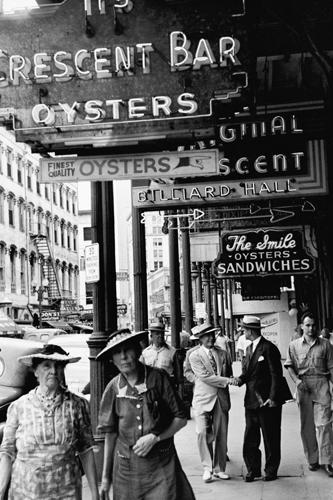 New Orleans Oyster restaurants, 1946
New Orleans Oyster restaurants, 1946
Speaking of why who gets elected matters
 Maryland Bus at the NIMCO Scrapyard.
Maryland Bus at the NIMCO Scrapyard.Today's Sun also reports, in "Ehrlich transit budget decried," about the road and highway dominant transportation agenda of the Republican Ehrlich administration in Maryland. From the article:
Baltimore's transportation chief criticized the Ehrlich administration's spending plans yesterday, saying that a recent six-year capital budget proposal shows a lack of commitment to mass transit in the region....Foxx zeroed in on the spending totals proposed for the Maryland Transit Administration in the "out years" - three or more years in the future - in the state's draft six-year capital transportation plan for 2006-2011. According to the Department of Legislative Services, the draft reduces capital spending for "transit system preservation" by $69 million compared with last year's version of the plan.
Prince George's County Maryland--no longer Ward 9
People often refer derisively to Prince George's County Maryland as "Ward 9" (DC has 8 wards) as that county was the primary destination for African-Americans moving out of the center city. These days, PG County is a majority African-American county with the highest income of any such county in the U.S., and this has been written up in many publications across the country, including the New York Times Magazine maybe 6 years ago.
Today's Baltimore Sun reports, in "Prince George's pivotal in '06 vote," that PG County is a lot more than merely a DC suburban bastion. From the article:
"The '06 election is going to be won or lost in Prince George's," said state Sen. Ulysses E. Currie, a Democrat from the county. "The governor was in Prince George's two days ago. Mfume was there. Ben was there. O'Malley was there. Everyone realizes you have to go through Prince George's.
"The story of the 2002 election was Gov. Robert L. Ehrlich Jr.'s ability to win over swing voters in moderate and conservative suburbs around Baltimore. But politicians and strategists from both parties say that demographics, voting patterns and the dynamics of this campaign will make Prince George's a pivotal battleground in 2006.
The county has long been neck-and-neck with Baltimore City as the state's most solidly Democratic jurisdiction - in presidential and gubernatorial races, both routinely give the Democratic nominee more than 75 percent of the vote. But in raw numbers, the growing suburban county has far eclipsed the city. Kathleen Kennedy Townsend, the Democratic nominee for governor in 2002, beat Ehrlich by nearly 106,000 votes in Prince George's. She won Baltimore City by 81,000 and Montgomery County by 67,000.
By itself, Prince George's offset Ehrlich's margin in 16 other counties combined, though his margins in Anne Arundel and Baltimore counties, where turnout was high, were enough to carry him to victory. Since then, more than 47,000 new Democrats have registered to vote in Prince George's. The county has the third-most registered voters in the state, behind Montgomery and Baltimore counties, and the most registered Democrats.
City or suburbs?
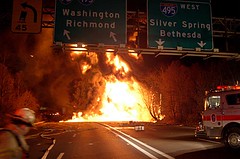 A tanker truck carrying 8,700 gallons of gasoline burns after exploding this morning on Interstate 95 north of Washington, D.C. The driver was able to escape unharmed after he noticed one of his rear wheels burning as he headed south from Baltimore.(Mark E. Brady -- Prince George's County Fire Dept. via AP) Nov 23, 2005
A tanker truck carrying 8,700 gallons of gasoline burns after exploding this morning on Interstate 95 north of Washington, D.C. The driver was able to escape unharmed after he noticed one of his rear wheels burning as he headed south from Baltimore.(Mark E. Brady -- Prince George's County Fire Dept. via AP) Nov 23, 2005
Inclusionary housing email list launched
As a follow-up to an October conference on inclusionary zoning, PolicyLink has launched an e-mail discussion group to continue sharing information and strategies. The conference was sponsored by PolicyLink, Innovative Housing Institute, National Housing Conference, and Business and Professional People for the Public Interest. According to PolicyLink, inclusionary zoning policies in Boston, New York, San Diego, San Francisco, and hundreds of other cities have produced tens of thousands of units of affordable housing. The online discussion provides a way to learn from peers about how to develop inclusionary zoning strategies that balance community needs for affordable homes with the needs of developers to realize a return on investment. Participants will also get the latest news on inclusionary housing advances. For details on joining the discussion group as well as other PolicyLink resources on inclusionary zoning and affordable housing, click here.
Blacks hurt by gap in home values
The Chicago Sun-Times reports racial disparities in home values in Chicago, and makes the point that "Haynes and many other black homeowners have long suspected that home values in black neighborhoods don't appreciate as fast as they do in white neighborhoods. Now, new research shows that not only do African-American homeowners typically get less when they sell their homes, but the disparity is feeding a growing wealth gap between blacks and whites."
I don't know Chicago very well, so I can't comment with any sense of authority about this. I will say that this supports my general point about historic preservation, and why residents of all races should support it, at least in DC.
1. Houses that maintain their architectural integrity tend to be valued more highly than houses that have their architectural integrity diminished, especially in historic districts.
2. Houses in historic districts tend to be valued more highly than equivalent houses that are not in designated historic districts.
3. Houses tend to comprise the most significant proportion of a household's (family's) wealth.
Because maximizing the value of a house tends to maximize a family's wealth, historic preservation adds value financially, not just in terms of a variety of other values that maintain and extend neighborhood livability.
For more information about this generally, I suggest reading Don Rypkema's paper, "Economic Power of Historic Preservation," and for more information about this specific to DC, I suggest reading another Rypkema paper, "Historic Preservation's Role in DC's Future."

 Images from the Chicago Sun Times.
Images from the Chicago Sun Times.
Granny units get (San Jose, CA) Council OK
I have argued for a couple years that alley dwelling units-carriage houses need to be brought back as a housing option for a couple reasons. One is that we need more housing types and options, especially as more and more housing units are converted away from rental housing. The other is that having people living on the interior of blocks will add more eyes on the street and safety in a neighborhood. All too frequently interior block alleys are avenues of concealment and abet crime.
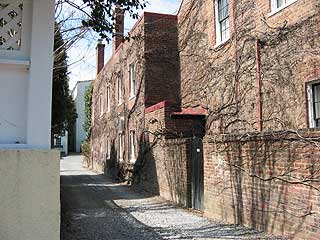 Alley, Georgetown, DC. Photo from www.homemade-ravioli.com.
Alley, Georgetown, DC. Photo from www.homemade-ravioli.com.Alley usage is coming back in places like Toronto (see "Building Back Alley") and Seattle (see "Cottage Housing in Your Community: A Guide to Drafting a Cottage Housing Ordinance" by the [Seattle] Housing Partnership).
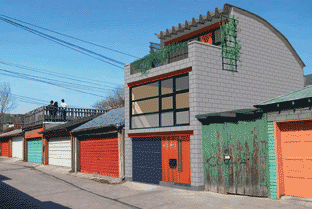 A computer model of what Stinson and Van Elslander imagine can be done on a slot lot, which could support a dwelling similar to an average one-bedroom apartment in Toronto. The rounded metal roof – a Quonset hut – is easily installed, sitting directly on top of the concrete block walls.
A computer model of what Stinson and Van Elslander imagine can be done on a slot lot, which could support a dwelling similar to an average one-bedroom apartment in Toronto. The rounded metal roof – a Quonset hut – is easily installed, sitting directly on top of the concrete block walls.(Note: I don't love this design, but it raises interesting ideas.)
The San Jose Mercury News reports about something a little different, secondary housing units (cottages) on larger lots, in the article "`Granny' units get council OK." But even so this policy change makes the same point. According to the article:
The program will be closely monitored, said Planning Director Stephen Haase, with a review in six months and another in a year. The criteria for entering the pilot program approved Tuesday include:
• Lots must be at least 6,000 square feet for units attached to the main houses, and 8,000 square feet for detached units.
• The units cannot be bigger than 600 square feet, with 400 square feet devoted to a bedroom. Contiguous storage space cannot exceed 10 percent of the total floor areas.
• One extra parking space would be required for the second unit. Two covered spaces are required for the occupants of the main house.
• Homeowners wanting to build backyard units must live on their properties when they apply for permits.
• The front door should not be visible from the street, and the unit should be built using materials identical to the main house.
• Detached units can be only one story, with a height limit of 16 feet.
For more info on the San Jose initiative, click here.
About a year ago, an urban design studio class at Catholic University's School of Architecture and Planning did their primary project on H Street NE issues. One of the areas they addressed, in some especially creative ways, were what they called "Accessory Dwelling Units" on alleys...
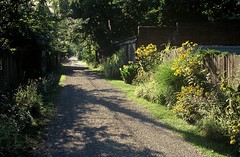 Tended alley in Richmond's Fan District. Photo by the "gardener," Calder Loth.
Tended alley in Richmond's Fan District. Photo by the "gardener," Calder Loth.
Renter displacement as an environmental impact (California)
The San Diego Union-Tribune reports, in "Policy may slow pace of condo projects," that:
In a move that could significantly slow the development of thousands of condominium conversion units, City Attorney Michael Aguirre said yesterday that apartment projects being converted to condominiums in San Diego must undergo an environmental review. The time-consuming new requirement is needed to address the environmental effects of the hundreds of condo-conversion projects moving forward in the city, Aguirre said.
Under state law, the net loss of rental housing, which has led to the displacement of renters, is considered an environmental impact, according to the City Attorney's Office. Aguirre's announcement, made public at a City Hall news conference, surprised the Development Services Department, which has been regularly processing hundreds of applications submitted by developers seeking to transform often-dated apartment buildings into gussied-up, for-sale condominiums.
----------
Well, I've always thought about these issues in terms of what I call "built environmental justice" which is a bit different from the body of work developed around environmental justice.
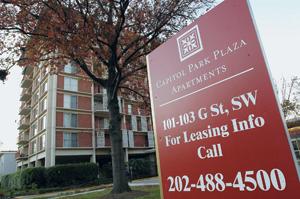 Tenants have taken the landlords of 101-103 G St. SW to court, claiming they were not notified when the building was sold. The landlords say the building was transferred, not sold. Amy Mullarkey/For The Examiner.
Tenants have taken the landlords of 101-103 G St. SW to court, claiming they were not notified when the building was sold. The landlords say the building was transferred, not sold. Amy Mullarkey/For The Examiner.Yesterday's Examiner reported on the ongoing investigation into DC condo conversions, in the article "D.C. inspector examining condo conversions: Graham says approval process was lax." According to the article:
"The D.C. inspector general has begun looking into the alleged "manipulation" of city zoning laws in more than 100 condominium conversions since 2000, according to several city officials."
Tuesday, November 22, 2005
Another troubling article in today's Washington Post
In the article "Howard U. Reaffirms Pledge to Build Hospital in SE," Howard University, like the Mayor's Office, says "damn the torpedoes, full speed ahead" even though many important questions are being raised about whether or not this hospital is a good idea or is needed.
Here's a troubling statement in the article: (emphasis added): "After two years of planning, negotiating and controversy, Howard University trustees have recommitted to their partnership with the city to build a $400 million hospital complex intended to fill gaps in acute and emergency care on the District's eastern side."
But no comprehensive health plan looking at gaps in acute and emergency care in the eastern quadrants of the city, let alone the whole city, has been conducted.
Then why should we rush pell mell into a $400 million construction project plus a commitment of maybe $200 million/year to run a hospital?
The quote is interesting also because now Howard U. and the Mayor's Office are focusing on "gaps in acute and emergency care" in response to pointed criticism that a hospital isn't necessarily the best way to address the most acute and public health needs (as opposed to hospital care) in the eastern quadrants.
This has been discussed in the blog before, as well as in DC Watch, through a number of entries by Dr. Eric Rosenthal.
This is but another example of how we aren't really doing any "comprehensive" planning in the city at all.
The drumbeat for selling off school property is getting louder and louder
As one entered Hall D for the Citizen Summit, a number of government agencies, and some other intrepid folk had booths.
One of the indefatigable presenters was Mary Rowse of Historic Washington Architecture, which took the opportunity to get more supporters for saving the Jesse Baltimore House--a house that the DC Parks and Recreation Dept. is happy to tear down for a bit of green space, even though it is the last house in a row of houses, and would be worth upwards of $700,000 if the house could be extricated from DC Government possession (technically it's owned by the National Park Service) and sold to someone who would actually take care of it.
The demolisher instincts are abetted by Councilmember Patterson's pandering to a handful of neighborhood residents who figure it's better to tear down the building than to count on DC Government actually taking care of the property (see this link for more info).
 The actual house in the Palisades is on the right. A photo, from the Sears House Catalog, of a model "Fullerton" kit-built house is on the left. Image by Peter Sefton.
The actual house in the Palisades is on the right. A photo, from the Sears House Catalog, of a model "Fullerton" kit-built house is on the left. Image by Peter Sefton.But I digress...
I talked with a government official and one of the things we talked about was the whole "Strategic Neighborhood Action Plan" planning process, back in 2001. I said that I was disappointed from the outset with this process--which was piloted in my neighborhood, so I guess I was one of the first people to be involved with SNAPs--because it didn't deal with or address foundational questions of what is a good neighborhood and why, what are the amenities that quality neighborhoods possess, etc. I felt that we were forced to operate with very severe blinders that overly narrowed our participation.
12 Principles of a Walkable Community -- are as good a place to start as any...
1. Intact town centers.
2. Residential densities, mixed income, mixed use.
3. Public Space.
4. Universal Design
5. Key Streets Are Speed Controlled.
6. Streets, Trails are Well Linked.
7. Design is Properly Scaled to 1/8th, 1/4 and 1/2 mile radius segments.
8. Town is Designed for People.
9. Town is Thinking Small.
10. In Walkable Communities There Are Many People Walking.
11. The Town and Neighborhoods have a Vision.*
12. Decision Makers Are Visionary, Communicative, and Forward Thinking.
He said he deals with the fallout from this, that most wards and neighborhoods don't really have good plans to work with...
I raise this because it is relevant to the People's Property Campaign, being coordinated by EmpowerDC, that I have mentioned from time to time. For a property to be declared "surplus" by the DC Government, it must be determined that there is "no further public use" for the property.
But there is no comprehensive process to determine if there are alternative public uses, or whether or not a neighborhood has a full complement of the municipal amenities and services necessary to create and maintain stable, livable, healthy communities.
For example, I am extremely bothered by the fact that right now we have at least four simultaneous but somewhat disconnected planning processes going on--the Comprehensive Plan revision, the DC Public Schools planning process, the DC Public Library planning process, and the DC Dept. of Parks and Recreation planning process.
The Comprehensive Plan effort is a somewhat bastardized process primarily concerned with land use, but also some "broader" issues such as "arts and culture."
The reality is that there is no "Comprehensive Plan" for the city, a plan that takes into account all quality of life and economic development vectors that should concern us.
This is relevant when reading Washington Post columnist Marc Fisher's column today "Fix Up Schools, But Not With Faulty System." In the column he makes a good point that it seems somewhat foolish to entrust $1 billion for school renovation and reconstruction to a school system that hasn't proven its ability to engage in such activities. But I also see him slobbering in favor of wanton privatization of public assets in his second to last paragraph:
Closing a few dozen schools could boost Mayor Tony Williams's plan to lure 100,000 new residents. Many schools sit on land that makes developers salivate. Developers are so hungry for land in every ward, they'd happily build new schools, free of charge. Doubt it? We just witnessed a wild bidding war for one of the city's most crime-ridden housing projects, Sursum Corda. The money is falling from trees.
School sites are just some of the public assets that belong to residents of the District of Columbia. Before we go off wantonly selling these properties, ought we not determine what other use such assets could perform in helping us to maintain and extend the quality of life in our city?
Because the Washington Post is so associated with the developer agenda, you do have to wonder about statements like that of Mr. Fisher...
In my conversation with that DC government official, he said that 100 years ago, say during the time of the McMillan Commission, urban planning was much different, that it was about quality of life, that today it is about economic development and fiscal realities.
I said two things to him. First, I said that earlier in the week I was in Manhattan and Brooklyn and that probably everyone who lives in either of those boroughs would prefer to live immediately adjacent to Central Park or Prospect Park.
Second, that it is "common knowledge" that houses in places with good schools, parks, and libraries are valued more highly than houses in neighborhoods lacking those amenities. For example, houses in Montgomery County in the geographies of the most successful high schools such as Walt Whitman or Richard Montgomery, cost much more than equivalent houses in areas where the high schools are less successful.
Frederick Law Olmsted wrote about this more than 120 years ago, in a letter to City of Boston officials, in pushing forward plans for new public parks. He wrote specifically about the value such parks provide and how adjoining land rises in value, and therefore, generates more property tax revenues.
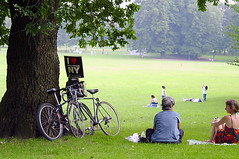
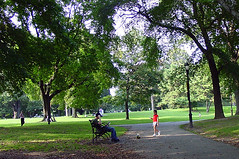 Prospect Park, Brooklyn. Photos: www.citying.com
Prospect Park, Brooklyn. Photos: www.citying.com_____________________
* From "How Can I Find and Help Build a Walkable Community"
11. The Town and Neighborhoods have a Vision. Seattle, Washington, Portland, Oregon and Austin, Texas are just three examples where neighborhood master plans have been developed. Honolulu sets aside about $1M per year of funds to be spent by each neighborhood. Visionary, master plans provide direction, build ownership of citizens, engage diverse people, and create opportunities for implementation, to get past sticky issues, and deal with the most basic, fundamental, necessary decisions and commitment. There are budgets set aside for neighborhoods, for sidewalks, trails, links, parks. The community no longer talks about where they will get the money, but how they will change their priorities.
Taiwan's edge in tourism lies in its "friendly people" and "delicious food
What edge does DC have? (You know my thoughts on this--architecture and history.)
Taipei, Nov. 22 (CNA) Taiwan's edge in tourism lies in its "friendly people" and "delicious food, " a survey of foreign arrivals released by the Tourism Bureau under the Ministry of the Transportation and the Communications showed Tuesday. The Tourism Bureau conducted the survey at the CKS International Airport and Kaohsiung Hsiaokang International Airport in the first half of the year in a bid to get a picture of the spending habits of tourists and their activities during their stays in Taiwan.
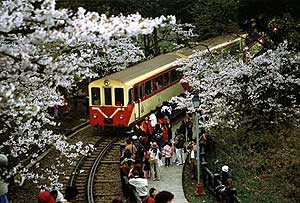 From "Touring Taiwan by Rail."
From "Touring Taiwan by Rail."Compared with neighboring countries such as Thailand, Japan, China, South Korea, Hong Kong, Singapore, Malaysia, Indonesia and the Philippines, foreign tourists think Taiwan's edge lies in its friendly people, (34 out of 100 cited this factor) , followed by delicious food (33 out 100) , consumer prices (16 out of 100) , and good social order (13 out of 100). Other factors cited included local customs, fine weather, tasty fruits, nighttime leisure activities, scenery, near proximity to scenic sites, historical artifacts, democracy and leisure facilities.
Foreign tourists made 1.65 million visits in the first half of the year, up 18.41 percent from the same period last year. Among them, 650,000 visits were for tourism, 46.14 percent higher than the same period last year. Tourism revenues in the first six months totaled NT$2.39 billion (US$71.34 million), up 29.62 percent from the same period last year. The overall approval rating of tourism in Taiwan was 84 percent, up 4 percentage points from the same period last year. (By Lilian Wu)
Updated -- ULI recommendations on New Orleans
are in this press release, "Moving Beyond Recovery to Restoration and Rebirth: Urban Land Institute Makes Recommendations on Rebuilding New Orleans," and include:
--The establishment of a temporary financial oversight board to ensure fairness and equity in obtaining federal funding (with members representing the federal, state and local governments); -- The establishment of a rebuilding corporation—the Crescent City Rebuilding Corporation—to expedite reconstruction of both residential and commercial properties;
--The recognition that every citizen has a right to return to a safe city (with enhanced levees and ecosystem restoration playing a key role in ensuring future safety);
--The adoption of clear criteria for neighborhood restoration and development, with an emphasis on the inclusion of residents in the planning and restoration;
--The acceptance that diversity, equity and cooperation are keys to rebuilding;
--The need for diverse economic development that results in the creation of a broader range of jobs providing a broader salary range (the panel also endorsed a requirement for a livable wage);
--The recognition of the influence of the faith-based community in maintaining the recovery's momentum;
--The need for tax reform and incentives to build up the city's tax base and encourage private investment; and
--The need for a regional approach on such critical issues as levees, transportation systems, emergency response and economic development.
______
Also see this article "Rebuilding should begin on high ground, group says," and this editorial, "It's time for a nation to return the favor," from the New Orleans Times-Picayune.
www.uli.org/nola is the master site of all current ULI activities concerning the reconstruction of New Orleans. This site includes a link to the Powerpoint Presentation that ULI presented that is referenced above. The report won't be finalized for a few weeks.
Iraq's oil: The spoils of war
This isn't a blog entry directly relevant to the topic, although automobile centric and dependent sprawl--which has been supported by various federal and state policies over the decades--causes extreme deprivation of most of the center cities in the United States by dispersing businesses and residents far from the core, wasting the value of what remains. Maintaining access to relatively cheap oil to continue to enable the sprawl development paradigm shapes a goodly portion of U.S. economic and foreign policy.
This article from the Independent (UK/London), on "Iraq's oil: The spoils of war ," discusses plans to award ownership interest in the Iraqi oil system could cost the country upwards of $200 billion of the value of this declining and depleting resource.
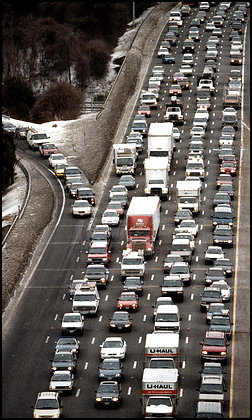 Beltway in Virginia. Washington Post photo.
Beltway in Virginia. Washington Post photo.
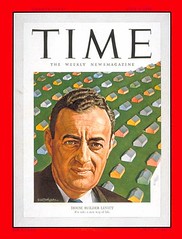 William Levitt created the first real large scale subdivision communities after World War II, first on Long Island, then in the suburbs of Philadelphia.
William Levitt created the first real large scale subdivision communities after World War II, first on Long Island, then in the suburbs of Philadelphia. Dead American military personnel returned from Iraq. The global is local.
Dead American military personnel returned from Iraq. The global is local.
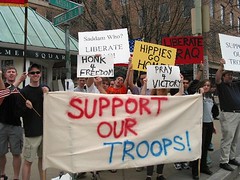 Princeton College Republicans support our troops.
Princeton College Republicans support our troops.The best way to "Support our troops" is to repopulate and revitalize the center cities, to reduce U.S. economic dependence on automobility and gasoline.
